Ever stared at your wilting Staghorn Fern and wondered, “Where did I go wrong?” Don’t worry, you’re not alone. Many of us have been in that same boat, trying to Save a Dying Staghorn Fern with no clue where to start.
In this guide, we’ll help you identify what’s causing your fern’s distress and offer some life-saving tips. So put on your gardening gloves and let’s dive in! Keep reading about ‘How to Save a Dying Staghorn Fern?’
Key Takeaways
- Identify signs of a dying Staghorn Fern: yellowing or wilting fronds, black spots, and pests.
- Correct watering practices are crucial; overwatering can lead to root rot.
- Provide adequate light but avoid direct sunlight which can burn the fern.
- Ensure proper humidity levels; misting can help in dry environments.
- Regularly feed with a balanced liquid fertilizer.
- Repot if necessary, using a well-draining potting mix and ensuring good air circulation around roots.
Understanding Staghorn Ferns
Before we dive into how to save a dying Staghorn Fern, it’s essential to understand what they are, where they naturally thrive, and the common varieties.
What is a Staghorn Fern?
A Staghorn fern is a unique type of fern known for its distinct antler-shaped fronds. Unlike your typical garden-variety fern, these guys are epiphytes, meaning they grow on other plants or objects for support.
Now onto their unique characteristics. These ferns have two types of fronds – the sterile and fertile ones. The sterile ones are flat and look like shields, while the fertile ones resemble deer or elk antlers – hence the name ‘Staghorn’.
The Natural Habitat of Staghorn Ferns
Staghorns naturally grow in the wild rainforests of Australia, Southeast Asia, Africa, and America’s East Coast. They’re typically found hanging off tree trunks or rocks.
As for specific conditions necessary for their growth, well, they love humidity and indirect sunlight. They’re not fans of cold weather though – anything below 55°F can make them throw a bit of a tantrum.
Common Varieties of Staghorn Ferns
There are several common types of staghorns, each with its own quirks. The Platycerium bifurcatum is one such variety that’s popular among indoor plant enthusiasts due to its compact size.
Next up is Platycerium grande – this big guy has large shield fronds that can reach up to 6 feet in diameter! Then there’s Platycerium veitchii which is known for its silvery-grey fronds that give it an almost alien-like appearance.
Lastly, we have Platycerium wandae – often called the queen of staghorns because she’s one of the largest species and can grow up to 6 feet tall. Now that’s a fern fit for royalty!
Identifying Signs of a Dying Staghorn Fern
If your staghorn fern is looking a bit under the weather, it’s crucial to identify the signs that it might be on its last legs. Let’s dive into some common staghorn fern dying signs.
Discoloration and Browning
Browning leaves? Yellowing fronds? These are classic symptoms of an unhealthy staghorn fern. Overwatering can often lead to discoloration, turning those once vibrant green leaves into a sad shade of brown.
But don’t panic just yet! It could also be due to a lack of nutrients. Like us humans, plants need their vitamins too! So, if you notice any browning staghorn fern leaves, it might be time for a nutrient boost.
Wilting and Drooping Fronds
Next up on our list of symptoms of sick staghorn fern are wilting and drooping fronds. If your plant looks like it’s had a rough night out, chances are something’s not quite right.
Improper watering or insufficient light could be the culprits here. Remember, these guys love their sunlight but not too much! So if you’re asking yourself “why are my staghorns wilting?”, check their sunbathing habits first!
Root and Crown Rot
Last but certainly not least, we have root and crown rot – two serious issues for any plant owner trying to save a dying Staghorn Fern.
Root rot is often caused by excessive moisture or poor drainage – think of it as your plant getting waterlogged. On the other hand, crown rot in staghorhns can occur when water gets trapped in the center of the plant.
So keep an eye out for these signs and remember: prevention is always better than cure when diagnosing staghorn fern issues!
Causes of a Dying Staghorn Fern
If you’re trying to save a dying Staghorn Fern, it’s crucial to understand what’s causing the issue. The main culprits are usually inadequate watering, incorrect light conditions, poor air circulation, and nutrient deficiency.
Inadequate Watering Practices
Watering is a tricky business when it comes to Staghorn fern care. Overwatering or underwatering can both lead to dying staghorn fern symptoms.
Overwatered ferns might show signs of water stress like yellow leaves, while underwatered ones could appear wilted or dry. Proper watering for staghorns is essential in preventing these issues.
Incorrect Light Conditions
Light plays a huge role in the health of your Staghorn fern. Too much sunlight can scorch the leaves, causing them to turn brown and crispy – not exactly the lush green look we’re going for!
On the other hand, low-light conditions can stunt growth and cause your plant to look leggy and sparse. Understanding Staghorn fern light requirements is key in reviving a dying staghorn fern.
Poor Air Circulation
Air circulation – or lack thereof – is another common cause of staghorn fern problems. Without proper airflow, your plant may become susceptible to diseases and pests.
Good air circulation helps keep the foliage dry and reduces the risk of fungal infections. So if you notice signs of poor air circulation like mold or mildew, it might be time to rethink where you’ve placed your plant.
Nutrient Deficiency
Last but not least, nutrient deficiencies can also lead to an unhealthy or dying Staghorn fern. These plants need certain nutrients to thrive – without them, they may show signs of nutrient deficiency like yellowing leaves or slow growth.
Feeding staghorns with a balanced fertilizer can help address this issue and bring your plant back to life. Remember, a little TLC goes a long way in Staghorn fern care!
How to Revive a Dying Staghorn Fern?
To revive a dying staghorn fern, it’s crucial to focus on four key aspects: watering techniques, light exposure, air circulation, and nutrient provision. Each of these plays a significant role in the overall health of your fern.
Adjusting Watering Techniques
Watering can be tricky! Overwatering or underwatering your staghorn can lead to its downfall. But don’t worry, we’ve got some staghorn fern watering techniques that’ll help you out.
Firstly, remember that these ferns aren’t cacti; they need regular watering but not too much. If you’re overwatering your fern, it might start to rot. On the other hand, underwatered staghorns tend to dry out and wilt.
So what’s the sweet spot? Well, aim for moist but not soggy soil. And if you’re dealing with an overwatered plant, let it dry out before the next watering session. With these tips in mind, you’ll be well on your way to reviving overwatered staghorns.
Modifying Light Exposure
Light exposure is another critical factor in staghorn fern care. Too much light can scorch the leaves while insufficient light can stunt growth.
Staghorns love bright but indirect sunlight. If your plant is getting too much direct sun, consider moving it to a shadier spot. Conversely, if it’s not getting enough light, try placing it near a window with filtered sunlight.
By adjusting the lighting conditions appropriately, you’ll be able to save an unhealthy staghorn fern from being underlit or overlit.
Improving Air Circulation
Good air circulation is like fresh breath for staghorns – they absolutely need it! Stagnant air can cause fungal diseases and attract pests.
To improve air circulation around staghorns, consider hanging them in a breezy area. If that’s not possible, a small fan can do the trick. Just make sure it’s not blowing directly on the plant to avoid drying it out.
With better airflow, you’ll be reviving staghorns and helping them breathe easier.
Providing Essential Nutrients
Last but certainly not least, your staghorn needs its vitamins! Essential nutrients are key to a healthy fern and can help resuscitate a wilting staghorn fern.
If your plant is looking a bit pale or its growth has slowed down, it might be nutrient-starved. A balanced liquid fertilizer can provide the necessary nutrients and give your fern a much-needed boost.
Remember, moderation is key – too much fertilizer can harm your plant. With these staghorn fern fertilization tips, you’ll have all the knowledge to feed your dying staghorn back to health!
Preventative Measures for Healthy Staghorn Ferns
Preventative measures are the best way to save a dying Staghorn fern. It’s like taking vitamins to avoid getting sick, but for your plant.
Regular Monitoring and Care
Keeping an eye on your fern is key to its health. Regular monitoring can help you spot any issues early on, before they become major problems. It’s all about being proactive rather than reactive.
Routine care is just as important. Think of it as the daily exercise and balanced diet for your fern. This consistent attention will keep your fern in tip-top shape.
Proper Placement and Potting
Location, location, location – it’s not just for real estate! Proper placement of your Staghorn fern can make a big difference in its health.
Potting techniques also play a role here. The right pot can provide the perfect home for your fern, promoting healthy growth and preventing potential issues.
Balanced Fertilization
Just like us humans need a balanced diet, so do our plants! Balanced fertilization ensures that your Staghorn fern gets all the nutrients it needs.
Too much or too little fertilizer can cause problems, so finding that sweet spot is crucial. Remember folks, moderation is key!
To Wrap Up
So, we’ve learned that saving a dying Staghorn Fern is like nursing a hangover after a wild night out – hydration and TLC are key!
Remember, your fern is not just a plant; it’s more like an eccentric roommate with specific needs. If you need more help, check out this guide on how to Save a Dying Staghorn Fern.



